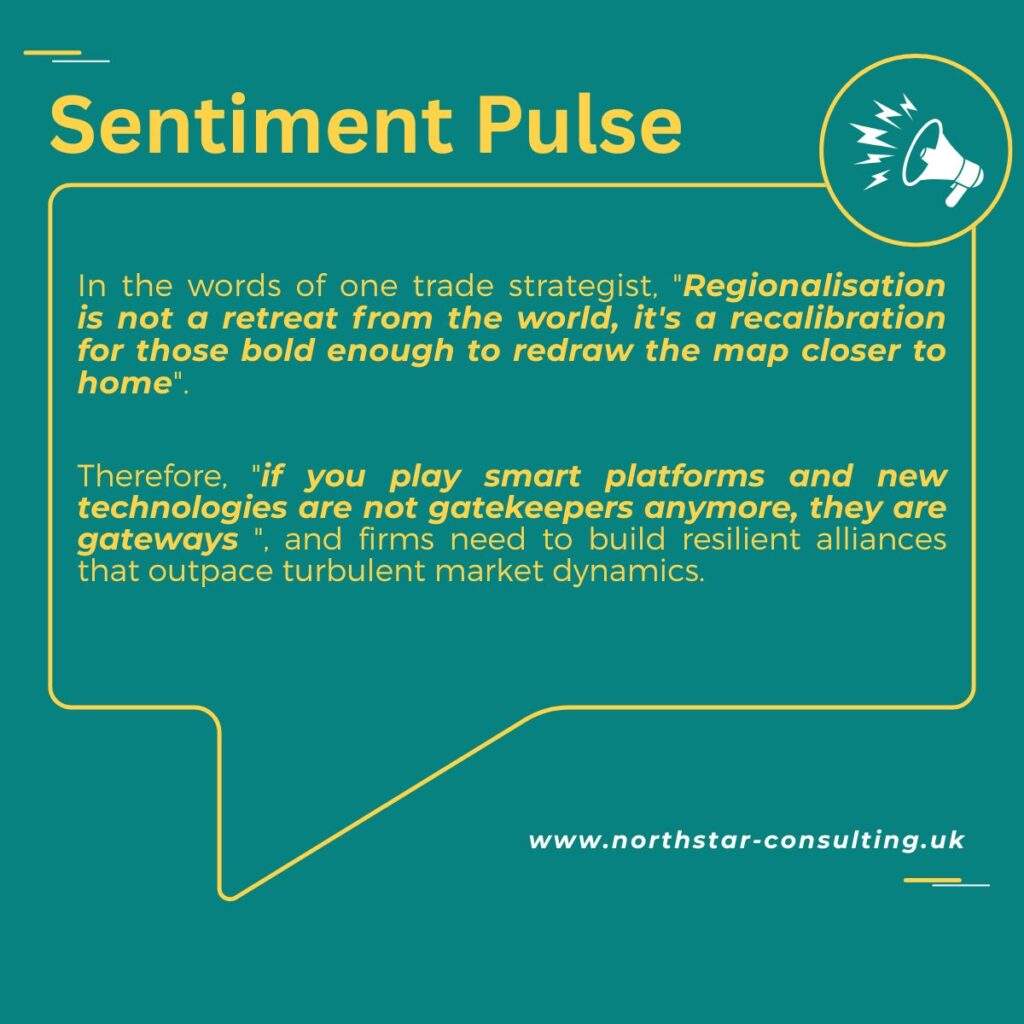This article is Part 3 of our series “Trade Winds 2025”, where we explore how shifting trends in trade impact the global economy and business around the globe.
You can find the two previous articles on The Pulse, our dedicated research and insights hub.
Where We Are Now
The last two years have done something useful – they have stripped away the old assumptions that once guided cross-border trade. The era when sheer volume could disguise weak margins and hidden costs is over. Global trade is not collapsing, it is being reconfigured. The rules of engagement are changing, and the impact is felt first and hardest by smaller firms.
For UK and EU SMEs, the message is “the world is moving from recovery to realignment”. Supply chains are being redrawn, regional blocs are tightening, and the cost of distance, both financial and geopolitical, is rising. What once depended on scale and low-cost sourcing now depends on agility, proximity and intelligence.
This is the new trade reality, where volatility has become structural, growth is increasingly selective, and opportunity lies in the speed of adaptation. The firms that recognise this shift early, by rethinking markets, localising suppliers and investing in digital visibility, will not simply survive the transition; they will lead the next phase of global trade.
Three Major Global Shifts
The first shift is regionalisation. Rising border friction, higher freight costs and geopolitical uncertainty are reshaping trade economics in favour of nearshoring and continental hubs. This is no longer theory. The World Bank notes that policy choices and tariff pressures are pushing firms to prioritise regional supply corridors over global ones. Closer suppliers shorten lead times, reduce risk and give SMEs greater control over landed costs and fulfilment. In a volatile world, proximity is becoming the new scale.
The second shift is platform concentration. Online marketplaces and major retailers are building fully integrated value chains that now manage warehousing, customs clearance, duty calculation and delivery guarantees. UNCTAD’s research shows how this digital consolidation gives large platforms scale advantages that can quickly become barriers for independent exporters. For SMEs, these partnerships can open doors to international markets, yet they can also create dependencies that erode autonomy and margins.
The third shift is technological rebalancing. Customs, logistics and compliance are no longer paper exercises; they are data-driven disciplines. AI and automation are transforming border operations, from risk scoring to tariff classification. Early adopters are already cutting clearance times and compliance costs, according to PwC’s latest analysis. For SMEs, even modest investment in digital trade tools can yield outsized gains in speed, accuracy and confidence.
Together, these shifts redefine what strategic growth means for SMEs. Selling everywhere from day one is no longer sustainable. The smarter approach is to treat international expansion as a sequence of deliberate experiments: validate demand through regional hubs, test logistics models with smaller runs, and price with full landed cost transparency rather than chasing headline discounts. McKinsey’s recent research shows that firms investing in logistics and customer experience capture a disproportionate share of value. The same lesson applies to SMEs. Resilience and adaptability now create more advantage than reach alone.

Advice About Moving Forward
This is a moment to build coalitions, not just capacity. Shared warehousing, cooperative customs brokers and export consortia are turning fixed costs into scalable, flexible programmes that make international trade more accessible for SMEs. Across Europe, collaborative logistics initiatives are gaining traction. The EU’s Single Market Programme promotes SME cooperation across borders, helping firms share infrastructure and reduce duplication. The European Cluster Collaboration Platform connects businesses to regional supply chains and logistics hubs, creating practical routes to scale.
Policy makers and business support agencies can amplify these efforts by bundling finance and logistics support into simple, low-friction schemes. When smaller firms pool demand and coordinate deliveries, the economics of regional fulfilment and bonded inventory suddenly make sense, an approach now tested through ongoing EU customs reform pilots.
At the same time, regulatory change should be treated as a strategic signal rather than compliance noise. When governments adjust tariffs, tighten borders or reconfigure trade policy, they reveal where friction will persist and where opportunity may emerge. The UK’s Border Target Operating Model illustrates this evolution, introducing digital pre-clearance and risk-based checks designed to make trade smoother for compliant businesses. Firms that map these regulatory shifts and price in tariff, tax and delivery implications will stay ahead of competitors who see such changes only as disruption.
In essence, the next phase of global trade belongs to SMEs that are selective, visible and collaborative. Build regional footholds, invest in digital trade tools that improve visibility, and partner with those who prioritise transparency over scale. The firms that do so will not simply survive this reorganisation of trade; they will define it.




